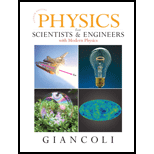
Two satellites orbit the Earth in circular orbits of the same radius. One satellite is twice as massive as the other. Which of the following statements is true about the speeds of these satellites? (a) The heavier satellite moves twice as fast as the lighter one. (b) The two satellites have the same speed. (c) The lighter satellite moves twice as fast as the heavier one. (d) The heavier satellite moves four times as fast as the lighter one.
Want to see the full answer?
Check out a sample textbook solution
Chapter 6 Solutions
Physics for Scientists and Engineers with Modern Physics
Additional Science Textbook Solutions
Sears And Zemansky's University Physics With Modern Physics
Conceptual Integrated Science
University Physics with Modern Physics (14th Edition)
College Physics: A Strategic Approach (3rd Edition)
Lecture- Tutorials for Introductory Astronomy
Essential University Physics (3rd Edition)
- For many years, astronomer Percival Lowell searched for a Planet X that might explain some of the perturbations observed in the orbit of Uranus. These perturbations were later explained when the masses of the outer planets and planetoids, particularly Neptune, became better measured (Voyager 2). At the time, however, Lowell had proposed the existence of a Planet X that orbited the Sun with a mean distance of 43 AU. With what period would this Planet X orbit the Sun?arrow_forwardIf a spacecraft is headed for the outer solar system, it may require several gravitational slingshots with planets in the inner solar system. If a spacecraft undergoes a head-on slingshot with Venus as in Example 11.6, find the spacecrafts change in speed vS. Hint: Venuss orbital period is 1.94 107 s, and its average distance from the Sun is 1.08 1011 m.arrow_forwardThe astronaut orbiting the Earth in Figure P3.27 is preparing to dock with a Westar VI satellite. The satellite is in a circular orbit 600 km above the Earth’s surface, where the free-fall acceleration is 8.21 m/s2. Take the radius of the Earth as 6 400 km. Determine the speed of the satellite and the time interval required to complete one orbit around the Earth, which is the period of the satellite. Figure P3.27arrow_forward
- Suppose the gravitational acceleration at the surface of a certain moon A of Jupiter is 2 m/s2. Moon B has twice the mass and twice the radius of moon A. What is the gravitational acceleration at its surface? Neglect the gravitational acceleration due to Jupiter, (a) 8 m/s2 (b) 4 m/s2 (c) 2 m/s2 (d) 1 m/s2 (e) 0.5 m/s2arrow_forwardA planet has two moons with identical mass. Moon 1 is in a circular orbit of radius r. Moon 2 is in a circular orbit of radius 2r. The magnitude of the gravitational force exerted by the planet on Moon 2 is (a) four times as large (b) twice as large (c) the same (d) half as large (e) one-fourth as large as the gravitational force exerted by the planet on Moon 1.arrow_forwardA satellite of mass 5500 kg orbits the Earth and has a period of 1.75 h. The mass of theEarth is 5.97×1024 kg, the radius of the Earth is 6.37×106 m, and G = 6.67× 10−11 N ∙ m2/kg2.(a) Determine the radius of its circular orbit.(b) Find the magnitude of the Earth’s gravitational force on the satellite.(c) Find the total energy of the satellite in its orbit.arrow_forward
- Find the orbital speed of a satellite in a geosynchronous circular orbit 2.5 X 107 m above the surface of the Earth. Where, G = 6.67X10-11 Nm2/Kg2M of Earth = 5.97x1024 kg Radius of Earth = 6.37x106 marrow_forwardA 216.2 kg satellite is geosynchronous orbit around the Earth stays over the same spot and takes 24 hours to make one revolution. Given the following data, determine the satellite’s height above the surface of the Earth. G = 6.67 x 10-11 Nm2/kg2, mass of Earth = 5.98 x 1024 kg, radius of Earth = 6.38 x 106 m.arrow_forwardThe Martian satellite Phobos travels in an approximately circular orbit of radius 9.4* 10^6 m with a period of 7 h 39 min. Calculate the mass of Mars from this information.arrow_forward
- 3. (a) At which of the indicated positions does the satellite in elliptical orbit experience the greatest gravitational force? (b) Have the greatest speed? (c) The greatest velocity? (d) The greatest momentum? (e) The greatest KE? (f) The greatest gravitational PE? (g) The greatest total mechanical energy?arrow_forwardHi please help: An earth satellite remains in orbit at a distance of 1.7900x10^4 km from the center of the earth. The Universal Grav constant is 6.67x10^-11N•m^2/kg^2 and the mass of the earth is 5.98x10^24 kg what speed (in m/s) would the satellite have to maintain? Answer in three significant figuresarrow_forwardA mass M is split into two parts, m and M - m, which are then separated by a certain distance. What ratio m/M maximizes the magnitude of the gravitational force between the parts?arrow_forward
 Principles of Physics: A Calculus-Based TextPhysicsISBN:9781133104261Author:Raymond A. Serway, John W. JewettPublisher:Cengage Learning
Principles of Physics: A Calculus-Based TextPhysicsISBN:9781133104261Author:Raymond A. Serway, John W. JewettPublisher:Cengage Learning College PhysicsPhysicsISBN:9781305952300Author:Raymond A. Serway, Chris VuillePublisher:Cengage Learning
College PhysicsPhysicsISBN:9781305952300Author:Raymond A. Serway, Chris VuillePublisher:Cengage Learning Physics for Scientists and Engineers: Foundations...PhysicsISBN:9781133939146Author:Katz, Debora M.Publisher:Cengage Learning
Physics for Scientists and Engineers: Foundations...PhysicsISBN:9781133939146Author:Katz, Debora M.Publisher:Cengage Learning Classical Dynamics of Particles and SystemsPhysicsISBN:9780534408961Author:Stephen T. Thornton, Jerry B. MarionPublisher:Cengage Learning
Classical Dynamics of Particles and SystemsPhysicsISBN:9780534408961Author:Stephen T. Thornton, Jerry B. MarionPublisher:Cengage Learning



